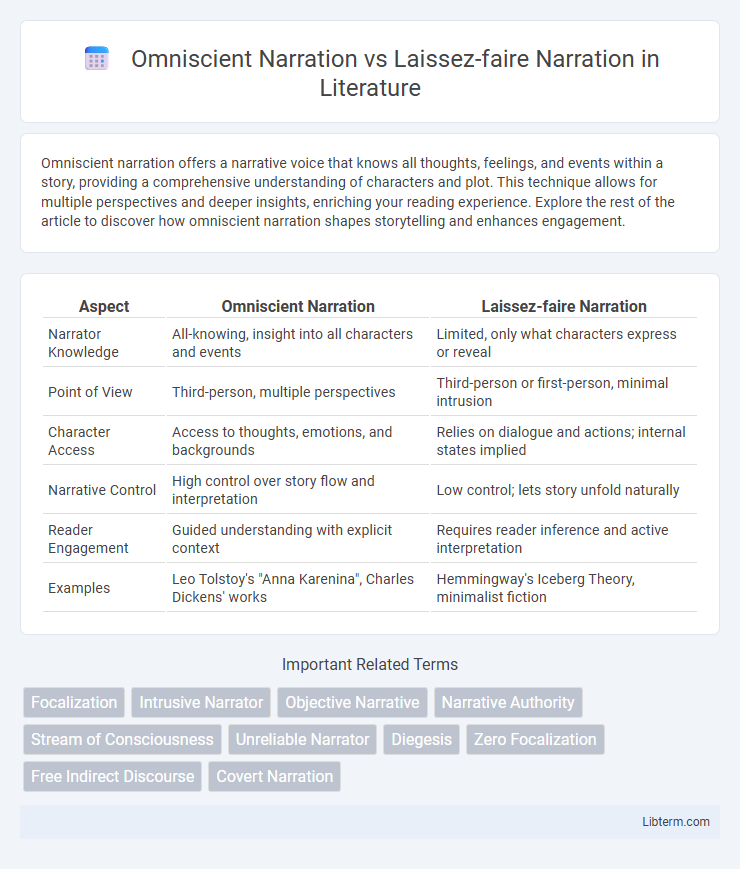Omniscient narration offers a narrative voice that knows all thoughts, feelings, and events within a story, providing a comprehensive understanding of characters and plot. This technique allows for multiple perspectives and deeper insights, enriching your reading experience. Explore the rest of the article to discover how omniscient narration shapes storytelling and enhances engagement.
Table of Comparison
| Aspect | Omniscient Narration | Laissez-faire Narration |
|---|---|---|
| Narrator Knowledge | All-knowing, insight into all characters and events | Limited, only what characters express or reveal |
| Point of View | Third-person, multiple perspectives | Third-person or first-person, minimal intrusion |
| Character Access | Access to thoughts, emotions, and backgrounds | Relies on dialogue and actions; internal states implied |
| Narrative Control | High control over story flow and interpretation | Low control; lets story unfold naturally |
| Reader Engagement | Guided understanding with explicit context | Requires reader inference and active interpretation |
| Examples | Leo Tolstoy's "Anna Karenina", Charles Dickens' works | Hemmingway's Iceberg Theory, minimalist fiction |
Introduction to Narrative Perspectives
Omniscient narration provides a comprehensive narrative perspective, revealing characters' thoughts, feelings, and unseen events, offering readers an all-knowing viewpoint. Laissez-faire narration, by contrast, limits insight into characters' internal states, relying on external actions and dialogue to convey the story, fostering reader interpretation. These narrative perspectives shape the storytelling style, influencing how much information is available and determining the reader's level of engagement with the narrative.
Defining Omniscient Narration
Omniscient narration is a storytelling technique where the narrator possesses complete knowledge of all characters, events, thoughts, and settings within the narrative universe. This narrative mode allows the narrator to provide insights into multiple characters' inner thoughts and unseen events, offering a comprehensive and all-knowing perspective. Unlike laissez-faire narration, which restricts the narrator's knowledge and interacts minimally, omniscient narration creates a more immersive and authoritative storytelling experience.
Understanding Laissez-faire Narration
Laissez-faire narration emphasizes minimal authorial intrusion, allowing characters and dialogue to drive the story naturally without explicit interpretation or commentary. This narrative style invites readers to actively engage in meaning-making by interpreting events independently, fostering a more immersive and open-ended reading experience. Unlike omniscient narration, which offers comprehensive insight into characters' thoughts and context, laissez-faire narration restricts information to what is observable within the narrative action.
Key Differences Between the Two Styles
Omniscient narration provides a comprehensive perspective by revealing the thoughts, feelings, and motivations of multiple characters, offering a detailed and all-knowing viewpoint throughout the story. Laissez-faire narration, in contrast, limits insight to external actions and dialogue, encouraging readers to interpret characters' inner lives without direct authorial guidance. The key differences lie in the scope of narrative knowledge and the degree of authorial control over what the audience understands about character psychology and plot development.
Historical Evolution of Narrative Techniques
Omniscient narration, rooted in classical literature, offers an all-knowing perspective that reveals characters' thoughts, emotions, and unseen events, a technique popularized by 19th-century authors like Leo Tolstoy and Charles Dickens. Laissez-faire narration emerged more prominently in modernist and postmodernist literature, emphasizing a limited or objective viewpoint that refrains from authorial intrusion, as seen in works by Ernest Hemingway and Raymond Carver. This shift reflects evolving narrative priorities towards realism, reader interpretation, and psychological depth over authoritative storytelling.
Impact on Character Development
Omniscient narration provides deep insight into multiple characters' thoughts and motivations, allowing for complex character development and multi-dimensional personalities. Laissez-faire narration limits the narrative perspective to external actions and dialogue, often leaving characters more ambiguous and open to reader interpretation. This restricted viewpoint can create a sense of mystery or realism but may hinder detailed psychological exploration.
Reader Engagement and Immersion
Omniscient narration provides comprehensive access to characters' thoughts and backgrounds, deepening reader engagement through a broad understanding of the story's emotional and thematic layers. Laissez-faire narration, by limiting insight to observable actions and dialogue, enhances immersion by encouraging readers to interpret motivations and fill narrative gaps independently. This balance between guided knowledge and reader inference shapes the level of psychological involvement and personal investment in the narrative world.
Notable Examples in Literature
Omniscient narration is prominently showcased in Leo Tolstoy's *War and Peace*, where an all-knowing narrator provides comprehensive insights into characters' thoughts and historical contexts, enriching the narrative depth. In contrast, laissez-faire narration appears in Ernest Hemingway's *Hills Like White Elephants*, where the narrator offers minimal commentary or insight, allowing readers to interpret dialogue and events independently. These distinct narrative styles shape readers' engagement by either guiding interpretation through detailed exposition or encouraging active analysis via narrative restraint.
Choosing the Right Narrative Approach
Selecting the appropriate narrative approach requires understanding the distinct advantages of omniscient narration and laissez-faire narration. Omniscient narration offers comprehensive insight into characters' thoughts and world-building, enhancing reader engagement through a multi-perspective view. In contrast, laissez-faire narration fosters reader interpretation and immersion by presenting the story with minimal authorial intervention, creating a subtle yet impactful storytelling experience.
Conclusion: Which Narration Suits Your Story?
Choosing between omniscient narration and laissez-faire narration depends on the desired level of reader insight and narrative control; omniscient narration offers a comprehensive viewpoint, revealing characters' thoughts and broader context, while laissez-faire narration limits information to dialogue and action, fostering reader interpretation. Stories requiring deep psychological exploration or complex world-building benefit from omniscient narration, enhancing clarity and thematic depth. In contrast, laissez-faire narration suits narratives prioritizing ambiguity, realism, and active reader engagement in meaning-making.
Omniscient Narration Infographic

 libterm.com
libterm.com